Last Updated on January 24, 2024 by Greg Gillson
Did you see a brightly colored red bird, orange bird, or yellow bird in Wyoming and wonder what it was?
This page is for you!
This article shows you photos and identification of some of the most common birds in Wyoming based on colors red, orange, and yellow.
The list of birds found in Wyoming includes over 440 species. So, I can’t show you all of them. I’m going to assume that you saw a common bird of this color, but you certainly could have seen something less common, or even rare!
Shape (including the shape of the bill) and size are often more helpful in starting to identify a bird than the color. In fact, most birds in North American can be easily identified with a black-and-white photo!
Many birds are multi-colored, so that it may be hard to pick out a dominant color. Males and females may be colored quite differently. And some color patterns are similar among otherwise dissimilar species.
Nevertheless, I’m going to try to pick out some of the birds that you are most likely to see in backyards or towns. And I’ll show a few others that I get asked about a lot.
The birds with a noticeable amount of red on them in Wyoming covered in this article are:
- American Robin
- House Finch
- Cassin’s Finch
- Broad-tailed Hummingbird
The birds with a noticeable amount of orange on them in Wyoming covered in this article are:
- Red-breasted Nuthatch
- Northern Flicker
- Barn Swallow
- American Kestrel
- Cinnamon Teal
- Bullock’s Oriole
- Black-headed Grosbeak
The birds with a noticeable amount of yellow on them, including lots of yellow and black birds, in Wyoming covered in this article are:
- Western Meadowlark
- Yellow-rumped Warbler
- American Goldfinch
- Pine Siskin
- Yellow Warbler
- Yellow-headed Blackbird
- Cedar Waxwing
- Western Tanager
- Western Kingbird
Red birds of Wyoming
Birds get the red, orange, and yellow in their feathers from carotenoids in the fruit, seeds, and plants they eat (source).
These carotenoid colors combine with melanin to form an infinite range of red feathers–pink, rusty, scarlet, violet, red-orange.
The following are red birds that you are most likely to see in Wyoming.
American Robin
These are familiar lawn birds with red breasts.
 |
| American Robin. Greg Gillson. |
Male American Robins are brownish-gray above with a brick red breast. Females are paler orange below and paler gray above.
They are widespread in open country with scattered deciduous trees, residential areas.
American Robins are year-round residents throughout Wyoming.
House Finch
When people ask about a bird with a red head at their feeder, it is usually this bird.
 |
| Male House Finch. Greg Gillson. |
Males of this dusty brown striped finch have red limited to the head (specifically the forehead and eyebrow), breast (chest), and rump. The red coloration tends toward orangish and may rarely be yellowish.
Females are streaked, similar to the males but without red. They lack any strong pattern on the face and head.
Note the small round head and curved upper ridge on the bill.
Some people call these red-headed sparrows. Sparrows and finches are similar, but in general, male finches are brighter than the females and tend to hang out more in trees. Sparrow genders are usually quite similar in coloration and tend to feed mostly on the ground.
These birds are common in residential areas, especially at bird feeders. In the West more widespread in arid regions near water.
House Finches are year-round residents in eastern, central, and southwestern Wyoming.
Cassin’s Finch
These red finches are found in ponderosa pine.
 |
| Cassin’s Finch. Greg Gillson. |
Males of these brownish finches are frosted with pink on the upper parts. The crown is the brightest red. They are not streaked on the under parts.
Females lack the red. They have a pale outline of the darker ear patch. Like the males, females are shaped with a large bill that is straight on the upper ridge. The tail is strongly forked.
These finches are found in dry mountain forests of ponderosa pine and juniper. Similar Purple Finches are found in deciduous and wet conifers. House Finches are found in towns everywhere.
Cassin’s Finches will visit feeders within pine forests.
Cassin’s Finches are year-round residents in central and western and southwestern Wyoming, summer resident in small area of northeastern Wyoming.
Broad-tailed Hummingbird
These hummingbirds of the mountain West have rosy-red throats.
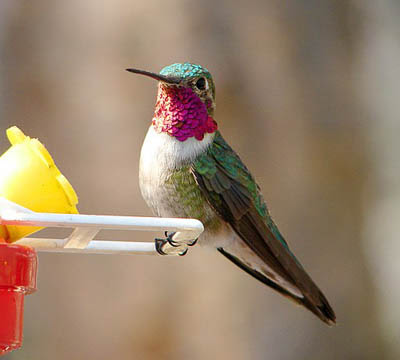 |
| Broad-tailed Hummingbird. Michelle Lynn Reynolds. CC BY-SA 3.0 |
Both genders are green above, white below, with green and buff flanks. Rusty bases to outer tail feathers.
Males have bright red throats.
Found in dry pine and montane forests.
Broad-tailed Hummingbirds are summer residents scattered primarily in southern and western Wyoming.
Orange birds of Wyoming
True orange-colored birds are not that common. Many birds that I have here are paler rusty.
The common pattern is an orange body and black or brown wings and tail. Another common pattern is for the orange to be restricted to the under parts.
The following are orange birds that you are most likely to see in Wyoming.
Red-breasted Nuthatch
These active little red-breasted birds crawls all around on the trunk and big branches of conifers. They search crevices in the bark for insect food.
 |
| Red-breasted Nuthatch. Greg Gillson. |
These tiny birds have blue-gray backs and a black line through a white face. Some males can have quite bright rusty red under parts. Some females can have quite pale buff-colored under parts. Most birds show an orange-cinnamon breast color.
Found nearly exclusively in conifers. Readily come to feeders.
Red-breasted Nuthatches are year-round residents throughout most of Wyoming, winter visitors only in southeastern Wyoming.
Barn Swallow
These orange-bellied birds are a familiar sight across North America in summer.
 |
| Barn Swallow. Greg Gillson. |
These birds are purple-blue above with orange under parts and long forked tails. The color of the underparts in winter or on females are often cinnamon or buff-colored, but breeding males can be brighter orange-red.
These birds swoop low over fields and wetlands at lower elevations. They may build their mud nests in rafters on porches, garages, or other out-buildings.
Barn Swallows are summer residents throughout Wyoming.
Northern Flicker
These unusual woodpeckers with orange under wings are just as likely to be found hopping on your lawn eating ants as they are to be calling from a dead treetop.
 |
| Northern Flicker. Greg Gillson. |
Where is the orange color?
Wait for it…
 |
| Northern Flicker. Greg Gillson. |
The shafts and undersides of the wing and tail feathers are a salmon orange color. A large white rump patch also attracts attention as these birds fly away.
Northern Flickers live in open woods, residential areas. Sometimes visit feeders in winter.
Northern Flickers are year-round residents throughout Wyoming.
American Kestrel
These are the familiar small rusty-orange falcons sitting on power lines on the edge of the highway or hunting and hovering over the median strip.
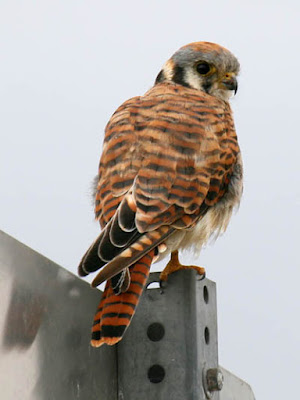 |
| Female American Kestrel. Greg Gillson. |
Females are rusty orange barred with black on their back wings and tail. The under parts are buff with black spots. The head shows two facial stripes.
Males have blue-gray backs and rufous tail is unmarked except for black tail band.
These birds are found in open country, farms, pastures with perches.
American Kestrels are summer residents throughout Wyoming.
Cinnamon Teal
What an unusually colored brownish-orange duck!
 |
| Male Cinnamon Teal. Greg Gillson. |
Males are dark cinnamon orange. The wing patches are blue, green, and white. The eye is red.
Females are more mottled brown with matching wing patches.
These birds are found in ponds and grass-lined ditches.
Cinnamon Teals are summer residents throughout most of Wyoming, absent in northeastern Wyoming.
Bullock’s Oriole
These bright orange and black birds are often seen in tall trees.
 |
| Male Bullock’s Oriole. Greg Gillson. |
The males of this species are very bright orange. The back and top of the heads are black. The black wings have large white wing patches. The tail is black with orange sides. The face is orange with a black line through the eye and a black throat.
Females and young are gray with yellow head and breast and tail.
These birds are more common in drier inland regions along watercourses in tall cottonwoods or shade trees. Rarely come to feeders for fruit or nectar in spring.
Bullock’s Orioles are summer residents throughout Wyoming.
Black-headed Grosbeak
If you didn’t look closely at these big-billed birds, you might mistake these orange-breasted songsters for American Robins–their coloration and song are very similar!
 |
| Male Black-headed Grosbeak. Greg Gillson. |
Males have black and white wings and tail. Huge bill. The under parts are burnt orange, fading to yellow-orange mid-belly.
Females and first year birds have a striped heads and are brown above, pale buff or butterscotch-orange below.
These birds are found in deciduous or mixed woods. Visit bird feeders.
Black-headed Grosbeaks are summer residents throughout Wyoming.
Yellow birds of Wyoming
Yellow is a common bird color! Often it is mixed with black and white plumage in birds.
Many birds with darker upper parts have yellow breast or belly.
The following are yellow birds you are most likely to see in Wyoming.
Western Meadowlark
These are streaky camouflaged prairie birds from above or from behind. But from the front, the breast is shocking yellow!
 |
| Western Meadowlark. Greg Gillson. |
They are streaked brown, black, and gray on the upper parts. The underparts are golden yellow with a black necklace crossing the upper breast. Much paler yellow in fall and winter, as the yellow feathers are tipped with white and streaked with brown.
These are birds of pastures and grasslands and arid regions.
Western Meadowlarks are summer residents throughout Wyoming, year-round residents in southeastern Wyoming.
Yellow-rumped Warbler
These are abundant warblers across North America. Affectionately called “butter butts” by many birders, because of their bright yellow rumps that flash in flight.
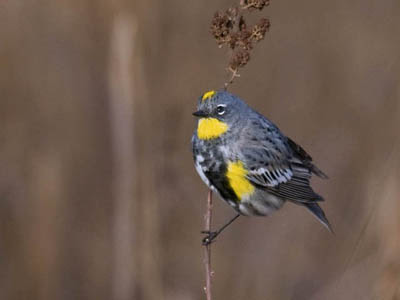 |
| Male Audubon’s Yellow-rumped Warbler. Greg Gillson. |
Western form (Audubon’s) with bright yellow throat and yellow rump. Large white wing patch.
Northern and Eastern form (Myrtle) with white throat, yellow rump, and two white wing bars.
Winter birds are dull gray-brown, with bright yellow rump. Throat may be cream colored or white. Often difficult to tell the two forms apart in winter.
 |
| Winter Yellow-rumped Warbler. Greg Gillson. |
Breed in mountain or boreal conifers. Widespread in migration. Winter in low river bottoms, open weedy deciduous areas. Rarely come to feeders in winter.
Yellow-rumped Warblers are summer residents in western Wyoming, spring and fall migrants in central and eastern Wyoming.
American Goldfinch
These small little birds are bright yellow and black.
 |
| American Goldfinch. Greg Gillson. |
Males are bright lemon yellow with black and white wings and tail, black cap. White under tail coverts. Pink bill.
Females are duller yellow below and brownish above. Lack black cap.
Winter birds are pale brown or gray, a touch of yellow on the throat of males.
These are birds of open country, fields with saplings, clear cuts, residential areas. They avoid dense forests, mountains, deserts. They visit feeders.
American Goldfinches are year-round residents throughout most of Wyoming, summer residents only in northeastern Wyoming.
Pine Siskin
These small brown-streaked birds are relatives of the goldfinches. But you would never know it until they fly and sport yellow wing stripes and tail base. Usually in flocks.
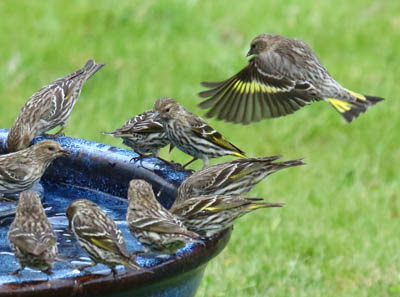 |
| Pine Siskin. Greg Gillson. |
These birds are streaked brown. In flight they have a yellow stripe down the length of the wing. The sides of the base of the tail is also yellow. Some birds are paler, some darker, others brighter yellow, others duller.
These birds are found in summer in northern conifer woods. Irregularly irrupt hundreds of miles southward. Frequent at feeders.
Pine Siskins are winter visitors throughout Wyoming, year-round residents in northwestern and southeastern Wyoming.
Yellow Warbler
The golden yellow sun packed all into one little bird! Appears to be an all-yellow bird.
 |
| Yellow Warbler. Greg Gillson. |
Some populations are bright yellow, some tend toward greenish on upper parts, some more golden. Yellow internal tail corners in flight.
Males with red breast streaking, again, variable by population.
Females somewhat to much paler yellow, some greenish, some whitish. Lack red streaks.
These birds are found in willow thickets on the edge of wetlands and ditches, stream sides in arid regions.
Yellow Warblers are summer residents throughout Wyoming.
Yellow-headed Blackbird
These blackbirds with yellow heads are found in marshes in the West.
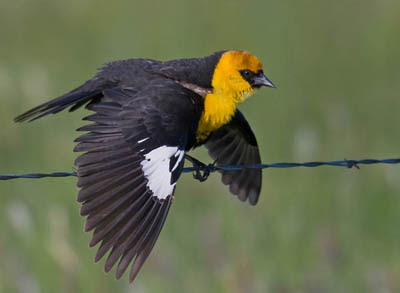 |
| Yellow-headed Blackbird. Greg Gillson. |
Males are glossy black with bright golden-yellow head and breast. White wing patches.
Females are duller brown with mottled yellow breast.
These birds nest in cattail marshes in prairies. Winter in large flocks in agricultural areas.
Yellow-headed Blackbirds are summer residents throughout Wyoming.
Cedar Waxwing
These crested birds with yellow band on the end of the tail are often found in flocks. They eat flying insects in summer, fruit and berries the rest of the year.
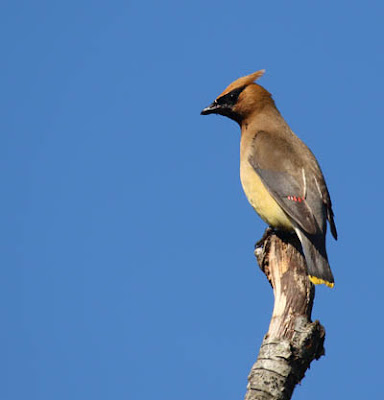 |
| Cedar Waxwing. Greg Gillson. |
These birds are fawn-brown above, with dark gray wings and tail. They have a black mask and wispy crest. The belly is yellow. The wings have waxy red drops on the end of the tertials. The end of the tail has a brilliant yellow tail band.
They are found in open habitats with berries, including juniper woodlands and towns in winter.
Cedar Waxwings are year-round residents throughout Wyoming.
Western Tanager
Numbers of these bright black and yellow birds may show up overnight in backyards in spring migration. Then they disappear the next night.
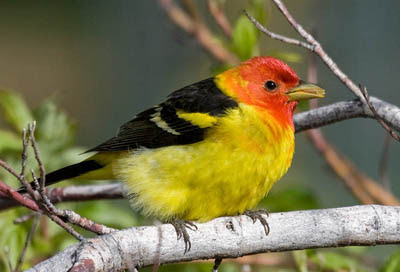 |
| Western Tanager. Greg Gillson. |
Males are brilliant golden yellow with black back, wings, and tail, and a red or orange face. Swollen yellow bill.
Females are more green or gray, with darker wings and tail. Lack red face.
They are found in a variety of wooded habitats, usually conifers or mixed conifer woods, and residential areas with large trees, including mature conifers. Usually don’t visit feeders.
Western Tanagers are summer residents throughout Wyoming.
Western Kingbird
These yellow-bellied birds of the prairies often perch on power lines and fence lines.
 |
| Western Kingbird. Greg Gillson. |
These birds are pale gray on the head and breast. Brown wings. The belly is lemon yellow. Black tail has white outer tail feathers, especially obvious in flight.
These are birds of prairies, deserts, pastures, often near water.
Western Kingbirds are summer residents throughout Wyoming.
Wrapping Up
Wyoming has some fantastic colorful birds but there are also many primarily black and white gems here. This is a list of my favorites:
Woodland Dwellers:
- Black-backed Woodpecker: This medium-sized woodpecker has a striking black back contrasted with white wing patches and barring on its underparts. They inhabit mature forests and woodlands, drumming on trees and feeding on insects and berries.
- Hairy Woodpecker: Similar to the Black-backed Woodpecker but with a white stripe down its back, this species occupies various wooded habitats. Listen for their loud drumming and tapping as they forage for insects and larvae hidden under bark.
- Black-capped Chickadee: These adorable and acrobatic songbirds sport a black cap, white cheeks, and a gray back. They thrive in coniferous forests and woodlands, flitting amongst branches and uttering their distinctive “chick-a-dee-dee” call.
- Mountain Chickadee: Found at higher elevations in coniferous forests, this chickadee shares similar markings with the Black-capped Chickadee but has a brownish wash on its flanks. Their high-pitched “chick-a-dee” call fills the mountain air.
Open Country and Wetlands:
- Black-billed Magpie: These intelligent and noisy birds are easily recognizable with their bold black and white plumage, long tails, and distinctive “magpie, magpie” call. They inhabit open areas like grasslands, farmlands, and even urban settings, feeding on insects, small animals, and carrion.
- Common Loon: This large, aquatic bird boasts a black and white checkered back and a white breast in its breeding plumage. Look for them on lakes and ponds, where they dive for fish and their haunting yodeling calls echo across the water.
Rare Beauties:
- Black Rosy-Finch: These high-altitude specialists display stunning plumage with black backs, rosy bellies, and white wing patches. They inhabit rocky slopes and alpine meadows, feeding on seeds and insects during the summer months.
- Harlequin Duck: This strikingly patterned duck features a black and white checkerboard back, white underparts, and a colorful head crest in males. Look for them along fast-flowing rivers and mountain streams, where they dive for aquatic insects and crustaceans.
Frequently Asked Questions
What kind of bird has a red head in Wyoming?
Wyoming boasts several bird species with distinctive red heads, each gracing different habitats and offering unique sightings. Here are some notable examples:
- Northern Flicker: This medium-sized woodpecker has a vibrant red crescent-shaped patch on its head, contrasting with its brown back and barred underparts. Look for them drumming on trees, foraging for ants on the ground, and uttering their loud, distinctive “wick-wick-wick” call.
- Red-breasted Nuthatch: These acrobatic songbirds sport a rusty-red breast and head contrasting with their gray back and white underparts. They efficiently climb down tree trunks headfirst, searching for insects and seeds hidden in bark crevices.
- Pileated Woodpecker: This impressive, large woodpecker features a bright red crest on its head, adding to its powerful presence. They inhabit mature forests, drumming loudly on trees and feeding on insects, larvae, and fruits.
- Red-headed Woodpecker: These distinctive birds boast a bold crimson head and neck contrasting with their black back and white wing patches. They inhabit open woodlands and edges of forests, readily spotted as they forage for insects, fruits, and nuts.
- Western Tanager: During the breeding season, male Western Tanagers display a fiery orange-red head contrasting with their bright yellow body and black wings. They occupy various forested habitats, particularly coniferous areas, where they feed on insects and berries.
What are the yellow and orange birds in Wyoming?
Western Tanagers are beautiful songbirds with vibrant orange-red heads and bright yellow bodies. They are migratory birds, breeding in Wyoming during the spring and summer months, typically from May to September. Here are some locations in Wyoming where you have a good chance of spotting them:
Mountain Ranges and Coniferous Forests:
- Grand Teton National Park: The lodgepole pine forests and willow thickets along the Teton Range offer excellent habitat for Western Tanagers. Look for them near Jenny Lake, Leigh Lake, and along trails in the Signal Mountain area.
- Yellowstone National Park: Lodgepole pine forests and spruce-fir forests throughout the park provide prime nesting grounds for these tanagers. Check areas like Hayden Valley, Lake, and the Bechler River drainage.
- Bighorn Mountains: Ponderosa pine and spruce-fir forests in the Bighorn National Forest and Bighorn Canyon National Recreation Area offer suitable habitat. Look for them near Sheridan, Buffalo, and Lovell.
- Medicine Bow National Forest: Lodgepole pine, spruce-fir, and aspen forests provide nesting and foraging opportunities. Check areas near Laramie, Saratoga, and Rawlins.
Related Articles:
See photos and learn about the most common backyard birds in Wyoming, regardless of color.
Here’s a quick tutorial of how I would teach you to identify birds: 7 Steps to Identify Birds!
Birds with red heads in North America.
Yellow-and-black birds in North America.










